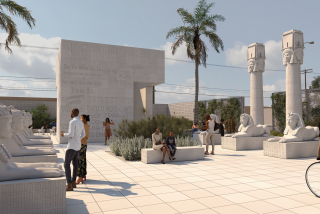Museum-Retail Project Nearing Completion on Santa Monica’s Main St.
Converting an old egg-packing plant into a museum for contemporary art has turned out to be a tougher task than developer Abby Sher first thought.
Several of the aging brick walls that Sher had hoped to restore could not be saved and had to be replaced. And a green tile, Art Deco facade is being reconstructed to “pay tribute” to the original, which also could not be preserved.
“We all know there are problems with renovation,” Sher said. “But this was beyond our imagination.”
Setbacks aside, however, construction of the museum and adjacent European-style marketplace at 2435 Main St. is now entering its final stages, and merchants could start moving in next month, Sher said.
“The main thing is that it is actually working out,” Sher said in a recent interview, adding that the museum will provide one of the Westside’s few nonprofit exhibition spaces open to the public.
The location for the $7-million complex was originally the site of an ice warehouse, built by the Imperial Ice Co. in 1908.
As refrigeration came into use, Edgemar Farms converted the warehouse and an adjacent building constructed in 1928 into an egg-processing plant.
Sher bought the property in 1984, hired Los Angeles architect Frank Gehry and began seeking city and Coastal Commission approval for the museum-retail-office complex.
The 10,200-square-foot museum sits on one corner of the site. A restaurant, shops and offices are clustered around a central courtyard.
The key to the project, Sher said, is the combination of a marketplace and museum. The juxtaposition is common in Europe, she said, but museums tend to be isolated in the United States.
“I never would have done a shopping center without a museum, but I wouldn’t do a museum without a shopping center,” Sher said.
“I want it accessible to people who don’t usually go to a museum. I want the museum to become a part of their daily lives.”
The focus of the art museum has shifted from local artists to both local and international artists, Sher said. There will be no permanent collection. Performing arts, such as dance, will also be featured from time to time.
Sher said the museum’s official opening will likely be in December, but a series of art shows is scheduled to begin in May.
Last month Sher announced the appointment of Thomas Rhoads, formerly with the New York State Council on the Arts, as director of the Santa Monica Museum of Art.
The 2,900-square-foot restaurant will occupy the building next to the museum. Sher said plans also include a produce market, fish and poultry store and bakery. She declined to further identify any of the prospective tenants.
Although many walls could not be preserved in the museum, Sher said she was able to repair and restore the arched, wooden trusses that stretch across the 25-foot ceiling. Inside the building, light streams in from long, vertical clerestory windows onto the original concrete floors.
The complex’s center plaza is dominated by an elevator shaft that rises about 30 feet from an underground parking garage. Sher said architect Gehry plans to cover it with chain-link fence, while other outer walls are being covered with galvanized metal siding.
Most of the permits to build the complex were approved in 1985. Sher originally sought and was granted a parking variance from the city to build the project with fewer spaces than normally required, but agreed to compromise after several Ocean Park neighbors concerned about development on Main Street objected.
She also agreed to restricted hours for the restaurant to accommodate residents concerned about late-night noise. However, Sher said this week that she will appeal those restrictions to the Planning Commission in a hearing scheduled for April 5.
More to Read
The biggest entertainment stories
Get our big stories about Hollywood, film, television, music, arts, culture and more right in your inbox as soon as they publish.
You may occasionally receive promotional content from the Los Angeles Times.











